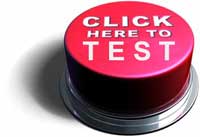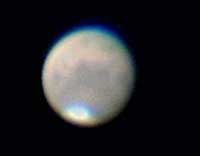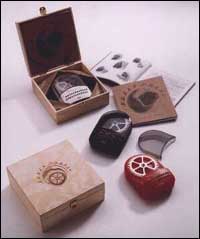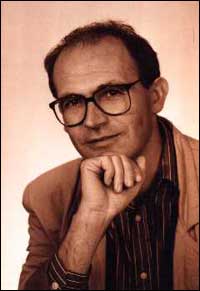
 Here's a most interesting and informative result from a classic experiment that has just been completed. I suspect that some readers may look upon it as a waste of time and money, a frivolous look at a ridiculous claim. I certainly do not have that view. Consider: the credophiles are fond of pointing out that scientists don't favor them by looking into their silly beliefs, and being told that science has more important things to do, does not satisfy them at all. Millions upon millions of people believe in astrology, dowsing, remote viewing, talking-with-the-dead, and other popular nonsense. These people deserve to have the opinions of legitimate scientists to consider; if they chose to ignore that information, that's their unwise choice. In America, at least, everyone has the right to be stupid or ignorant.
Here's a most interesting and informative result from a classic experiment that has just been completed. I suspect that some readers may look upon it as a waste of time and money, a frivolous look at a ridiculous claim. I certainly do not have that view. Consider: the credophiles are fond of pointing out that scientists don't favor them by looking into their silly beliefs, and being told that science has more important things to do, does not satisfy them at all. Millions upon millions of people believe in astrology, dowsing, remote viewing, talking-with-the-dead, and other popular nonsense. These people deserve to have the opinions of legitimate scientists to consider; if they chose to ignore that information, that's their unwise choice. In America, at least, everyone has the right to be stupid or ignorant.
But there's something more important here, I think. In the experiment to be described, there was more data derived than simply the fact that a claim was shown to be ludicrous. Read the account, and see if you agree with me.
Michael Lyvers, Associate Professor of Psychology at Australia's Bond University in Queensland, reports that on June 18 of this year, Channel Nine Australia's popular news program "A Current Affair" filmed an experiment conducted by Bond psychologists Norman Barling, Michael Lyvers and Jill Harding-Clark that was designed to test the claims of a well-known Australian "psychic healer" Dennis Puffett. Australia seems particularly fond of this sort of magical claim, but few claimants are as "far out" as Puffett, who says he can relieve pain simply by manipulating his subjects' photographs, even when the "patients" themselves are far away — even on another continent. I'm familiar with claims of "psychic diagnosis" by photo, but this "healing-by-photo" was a new one on me.
The Bond experimenters used twenty volunteers, obtained through newspaper ads, who said they suffered from chronic pain. These people were randomly assigned to either a "treatment" or a "control" group, ten per group. Their photos were taken, then they filled out a questionnaire designed to assess their personal belief in psychic healing, paranormal phenomena, hypnosis and alternative medicine. Next, they each filled out an initial McGill Pain Questionnaire (MPQ). This is a method of providing a "quantitative measure of clinical pain." This way, a baseline evaluation was obtained for the beginning of an attempt to test Puffett's claim.
Keeping all the participants waiting in a nearby room, the experimenters gave Puffett each photo, as well as information about the type and location of the person's pain. All of this was recorded by the TV crew. Puffett did his thing, attempting to relieve the pain of each participant whose photo he was given, and he was allowed as much time as he required. Following this, a second MPQ evaluation was done of each volunteer. A double-blind system was used, that is to say, neither the participants nor the psychologists who evaluated them, knew to which of the two groups any participant belonged — treatment or control.
(My question here must be, though the volunteers were not aware of which group they belonged to, did they even know that there were these two groups? I feel that they should not have known.)
The participants were then assembled, and a reporter from Channel Nine — who was of course also "blind" to each participant's group — asked them to raise their hands if they'd felt any improvement in their pain. Eight participants raised their hands; five of those were from the "control" group. Analysis of the two MPQ questionnaires showed no difference between treatment and control groups. Exactly half of the participants in each group gave worse ratings and half gave better ratings on the second MPQ, which is what would be expected by chance. Thus, the findings unequivocally showed no effect whatsoever by the "psychic healer," despite his animated claims to the contrary.
That's what we might expect from such a bizarre claim, but some very interesting findings were also to be seen. The eight volunteers who reported that they felt better after the "treatment" showed, to a statistically significantly level, a higher belief in alternative medicine, compared to the twelve participants who said they didn't feel better. Even more interesting, the MPQ showed highly and statistically significantly correlation with the "feeling-better" volunteers' belief in alternative medicine, psychic phenomena, psychic healing, hypnosis, and in Puffett's psychic healing claims. Thus, whether they were in the "healing" or in the "control" group, those who had strong beliefs in these five highly doubtful matters, tended to show positive changes on the MPQ over the course of the experiment, whereas those without such beliefs did not.
These experiments indicate that reports of so-called "psychic healing" are the results of a kind of placebo effect that is strongly dependent upon the subjects' degrees of belief in such claims. So, we have learned more that what we already expected, that Puffett's claim is spurious; we know now that people will possibly feel much better, even when treated by a quack.
But the problem I see here is that, as I've said so many times before, the aim of medical intervention should be to solve the problem, not to merely palliate the discomfort — though that is often the only action that can be offered to a patient. Feeling better is not necessarily being better, and there should be no confusion by the patient between these two conditions.
I could not resist this. Fabio, in Brazil, reminds me of a few definitions from Ambrose Bierce's infamous "Devil's Dictionary" of 1906:
Faith, n. Belief without evidence in what is told by one who speaks without knowledge about things without parallel.Koran, n. A book which Mohammedans foolishly believe to have been written by divine inspiration, but which Christians know to be a wicked imposture, contradictory to the Holy Scripture.
Christian, n. One who believes that the New Testament is a divinely inspired book admirably suited to the spiritual needs of his neighbor. One who follows the teachings of Christ in so far as they are not inconsistent with a life of sin.
Ambrose sure didn't worry about a possible afterlife, obviously. Interesting chap. Look him up.
A valued reader who will be un-named sent me this about my recent page on my atheism (brightness?):
Re your commentary on religion. Knowing you like quotes, this one by Santayana is right on target. "That fear created the gods is perhaps as true as anything so brief could be on so great a subject."
I'd not heard that one before, but I like it a lot...
Reader Diana Thoren informs me:
Today on [the] Montel [Williams TV show] someone in the audience asked Sylvia [Browne] if she could ever predict things for herself. She said no, or she wouldn't have had so many failed marriages. Everyone laughed, and Montel said that she can't predict things for him, either, because the closer she gets to people the fewer predictions she gets for them. Then Sylvia said, "The more I love you, the less I see." Convenient, don't you think?
Yes Diana, very convenient. But it brings up an idea. If it's "The more I love you, the less I see," surely it's also "The less I love you, the more I see"? It seems to me that Sylvia should have an excellent rapport with me, then! She should be able to see everything for me, even if it's not on a clear day...!
It's Sylvia's 885th day since she first agreed to take the test...
From UK reader Karel de Pauw comes this notice posted about some of the products available from the pharmacy in his local Sainsbury Supermarket....
MagnotherapyFor centuries, the healing properties of magnetism have been used to relieve arthritis, back pain, fatigue, insomnia, migraine and stress and to treat many other muscular ailments and pains. Magnotherapy stimulates blood flow to increase absorption of oxygen, nutrients and waste products; assisting natural healing, helping to combat pain and boosting stamina in most hot blooded animals, including humans, horses, cats and dogs.
"Magnetic energy has a beneficial effect on blood circulation, lymph flow, hormone production, nerves and muscles." — Dr. Ulrich Warnke, M.D. — from "Magnets to Overcome Pain. The New Healing Method"
"The application of a magnetic field has the virtues of simplicity, freedom from danger and low cost. It offers the lay man or woman a suitable form of self treatment for the minor ills of everyday life." — Dr. Evelyne Holzapfel — "Magnetic Therapy"
More of this balderdash can be seen at www.hoopers.org.
Now for some real science. The Red Planet is getting closer to us day by day, and on Wednesday, August 27th, it will be 69 times as bright as it was on August 12th of last year, when it put on a magnificent display. The last time that Mars was closer to Earth than it will be this time, was September 12, 57617 B.C.E. Accordingly, it has been about 60,000 years since it's has been as close as it will be on the 27th, a mere 34,646,418 miles away from Earth, and in an ideal presentation mode, so now would be a great time to acquaint yourself with our close neighbor. Stargazers have long been fascinated with Mars because of its distinct reddish color and quick movement against the background of stars.
A Martian day is about 25 hours long, and its year is about 23 Earth months. It has two tiny moons, elliptical in shape because gravity has not made them round, as is the case with our own  Moon. They are named Phobos (Greek for "fear") at a diameter of 16 miles, and Deimos (Greek for "terror") which has a diameter of just 9 miles. If you’re lucky and have a clear atmosphere, a simple telescope or exceptional binoculars, you should get a great look at Mars, and maybe a marking or a bright polar cap, as well.
Moon. They are named Phobos (Greek for "fear") at a diameter of 16 miles, and Deimos (Greek for "terror") which has a diameter of just 9 miles. If you’re lucky and have a clear atmosphere, a simple telescope or exceptional binoculars, you should get a great look at Mars, and maybe a marking or a bright polar cap, as well.
Here's a photo sent to me by our good friend James McGaha, director of a private observatory outside Tucson, Arizona. This photo is remarkable because it was taken just recently with a very simple web camera, and a number of the frames were added together by computer means to produce this image. Go to www.grasslands.org to see James' site.
 I received this enthusiastic report from a reader, Adam, the report shown here without anything but major corrections:
I received this enthusiastic report from a reader, Adam, the report shown here without anything but major corrections:
Subject: Egely WheelThere is an interesting device named: "Egely Wheel". Its actually uses brain waves, trapped and collected them with a very special "gear" shaped antenna, as they makes this antenna continusly rotating, sometimes very fast (compare to their weakness) 1-24 RPM! You can take the device apart, but wont be able to find anything inside that makes the wheel turn. Its basically empty inside but the wheel certainly rotates, as better you concentrate as fastest it will! On the founders website you will find further explonation, and experiments. Also can anyone reproduce this effect in a small 1cm deep see thru (plastic or glass) dish filled with water and any little piece of a "marker" that will indicate as the water moves. The little piece of "marker" can be anything (example: plastic or such), but it has to be floating on the waters surface. Then you have to place your hand close to the dish, and concentrate....and the water will slowly rotate in the dish! Unbelivable! Note: This is NOT bodyheat, and NOT electrostatic (charge) effect.
More info:
http://www.egely.hu/index2.htm
http://www.braincourse.com/wheelform.html
http://www.toolsforwellness.com/54848.html
 Well, I know "Dr." George Egely from past experience. All of Hungary knows him, from his pompous declarations of magical devices and super-science. Just read this excerpt from his description of the "Wheel Vitality Meter" that he peddles for $159.95:
Well, I know "Dr." George Egely from past experience. All of Hungary knows him, from his pompous declarations of magical devices and super-science. Just read this excerpt from his description of the "Wheel Vitality Meter" that he peddles for $159.95:
You can use this small, handy instrument just for fun or to obtain objective measurements of your own life energy. Without even touching it, you can measure for yourself how your personal environment, your activities and your lifestyle influence your day to day vitality level. . . . The key component is a 70 mm wheel that rotates on a delicate pivot fueled by your life energy. Simply remove the plastic cover and cup one of your hands around the vitality meter, surrounding it as completely as possible with your fingers and palm. The wheel will rotate as you concentrate.
Folks, this is a very old stunt, used by carnival hucksters for generations to convince gullible victims that "energies" are being demonstrated. That little wheel will spin around under any influence, but not if it's carefully shielded from outside drafts or the user's breath. This is just so typical of such quackery, and it's gobbled up eagerly by the faithful.
In May this year, the Independent Television Commission (ITC) in the UK ruled that two programs, "Crossing Over" and "6ixth Sense," were in breach of the Program Code, but would not have been, had they been clearly presented as entertainment. The ITC news release is on the ITC website: http://www.itc.org.uk. A proposed revision to the code sets out to make a distinction between purported contact with the dead — which could be considered "occult," and that which could be acceptable under certain conditions, including when clearly presented as entertainment, and at times when it is unlikely that a significant number of children are expected to be watching. Why? Is it obscene? Adults can go for this nonsense, but kids can't? What are the standards here?
The ITC's proposed wording of Section 1.10 now reads as follows:
Actual demonstrations of exorcisms and occult practices, such as those involving the purported invocation of unknown spirits or negative forces, are not acceptable in non-fictional programming except in the context of a legitimate investigation. They should not, in any case, be shown before the watershed. Horoscopes, palmistry and similar "psychic" practices are acceptable only when they are presented as entertainment or are the subject of legitimate investigation. They should not include specific advice to particular contributors or viewers about health or medical matters or about personal finance. They should not be included at times when large numbers of children are expected to be watching.
Come on, folks! What's this "legitimate investigation" stuff? Certainly not an investigation of whether there's any legitimacy in the processes involved! Do the Easter Bunny and Cinderella qualify as "legitimate" subjects for "investigation"?
Following a consultation in 2001, the ITC Program Code was revised to allow greater freedom to include alternative beliefs and practices on screen. Prior to that, all demonstrations of exorcisms or psychic or occult practice were forbidden, except "in the context of a legitimate investigation." The amendments were also in line with the expectations of viewers expressed in specially commissioned research into opinions on alternative beliefs and practices. Well, I'm still asking about Cinderella…
I'm away in the UK right now, returning very soon. Apologies for the short page this week…
